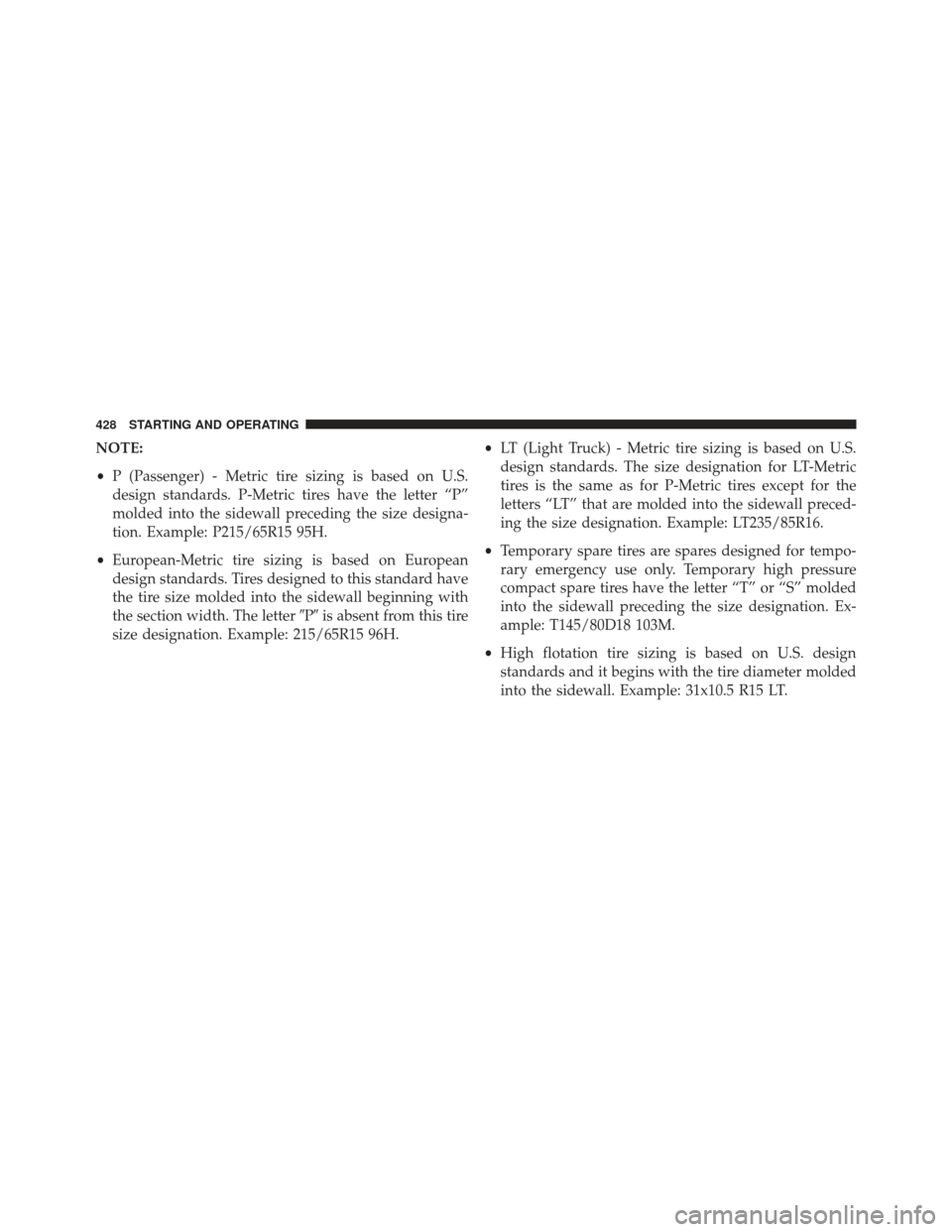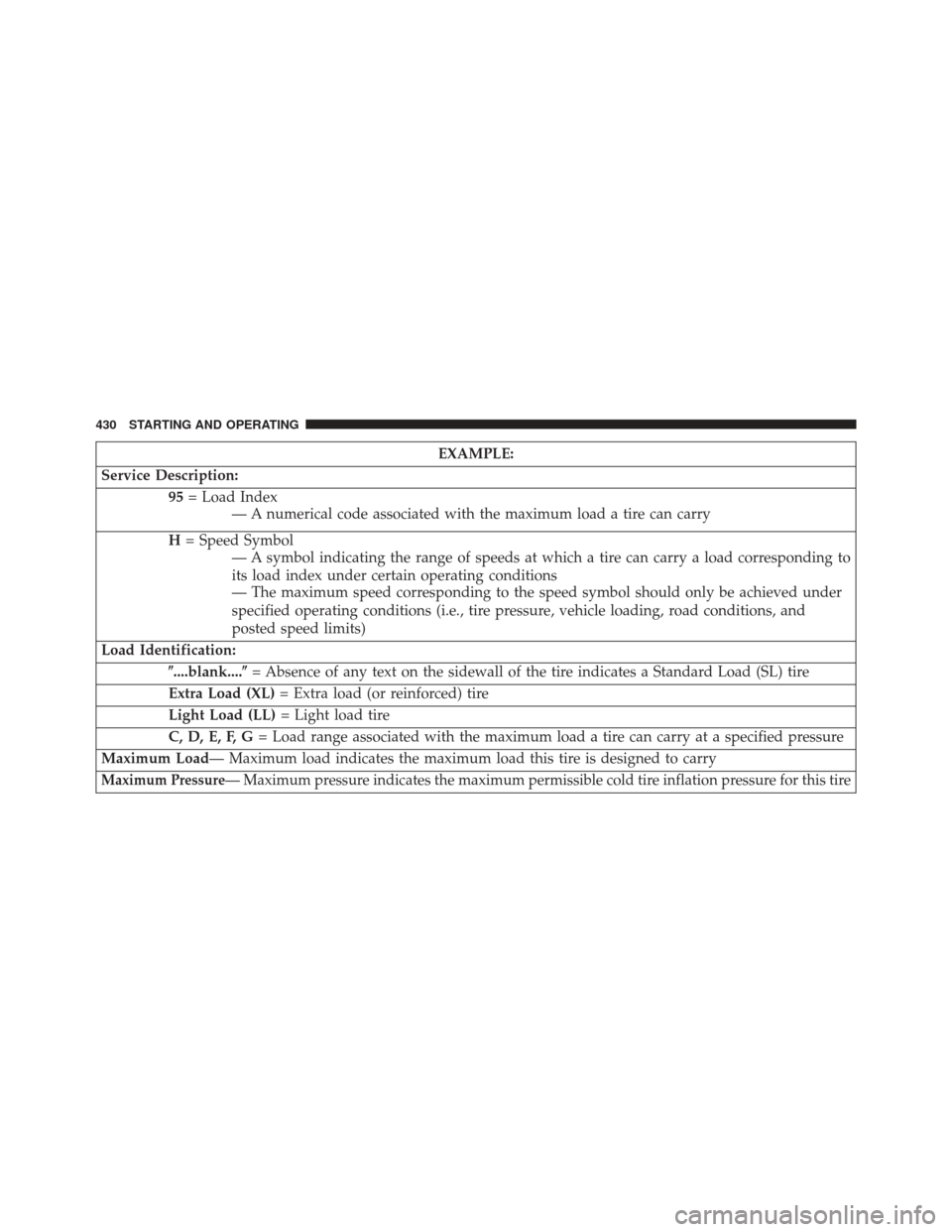Page 390 of 599

�DRIVING THROUGH WATER .............410
▫ Flowing/Rising Water ..................410
▫ Shallow Standing Water .................411
� POWER STEERING .....................412
� FUEL SAVER TECHNOLOGY —
IF EQUIPPED ......................... .413
� PARKING BRAKE ..................... .413
� ANTI-LOCK BRAKE SYSTEM .............416
� ELECTRONIC BRAKE CONTROL SYSTEM . . . .418
▫ Anti-Lock Brake System (ABS) ............418
▫ Traction Control System (TCS) ............418
▫ Brake Assist System (BAS) ...............419
▫ Electronic Stability Control (ESC) ..........419▫
Hill Start Assist (HSA) .................423
▫ Ready Alert Braking ...................425
▫ Rain Brake Support ....................425
▫ ESC Activation/Malfunction Indicator Light
And ESC OFF Indicator Light ............426
▫ Synchronizing ESC ....................427
� TIRE SAFETY INFORMATION .............427
▫ Tire Markings ....................... .427
▫ Tire Identification Number (TIN) ...........431
▫ Tire Terminology And Definitions ..........432
▫ Tire Loading And Tire Pressure ...........434
� TIRES — GENERAL INFORMATION ........438
▫ Tire Pressure ....................... .438
388 STARTING AND OPERATING
Page 391 of 599

▫Tire Inflation Pressures .................439
▫ Tire Pressures For High Speed Operation . . . .440
▫ Radial Ply Tires ..................... .441
▫ Tire Types .......................... .442
▫ Run Flat Tires ....................... .443
▫ Spare Tires ......................... .443
▫ Tire Spinning ....................... .446
▫ Tread Wear Indicators ..................446
▫ Life Of Tire ........................ .447
▫ Replacement Tires .....................447
� TIRE CHAINS ........................ .449
� TIRE ROTATION RECOMMENDATIONS .....450
▫ Tire Rotation ........................ .451�TIRE PRESSURE MONITOR SYSTEM (TPMS) . . .451
▫
Premium System ..................... .454
▫ General Information ...................457
� FUEL REQUIREMENTS ..................458
▫ 6.4L Engine ......................... .458
▫ Reformulated Gasoline .................458
▫ Gasoline/Oxygenate Blends ..............459
▫ E-85 Usage In Non-Flex Fuel Vehicles .......459
▫ MMT In Gasoline .....................460
▫ Materials Added To Fuel ................460
▫ Fuel System Cautions ...................461
▫ Carbon Monoxide Warnings .............462
5
STARTING AND OPERATING 389
Page 425 of 599

WARNING!
In the ESC “Full Off” mode, the engine torque
reduction and stability features are disabled. There-
fore, the enhanced vehicle stability offered by ESC is
unavailable. In an emergency evasive maneuver, the
ESC system will not engage to assist in maintaining
stability.�ESC Off� mode is intended for off-highway
or off-road use only.
NOTE: When the ESC is switched OFF, a feature of the
system remains active. This feature controls wheel spin
across an axle quite similarly to a limited slip differential.
If one wheel on an axle is spinning faster than the other,
the system will apply the brake of the spinning wheel
and allow more engine torque to be applied to the wheel
that is not spinning. To improve the vehicle’s traction when driving with tire chains, or when starting off in
deep snow, sand, or gravel, it may be desirable to switch
to the “Partial Off” mode by momentarily pressing the
“ESC Off” switch.
Hill Start Assist (HSA)
The HSA system is designed to assist the driver when
starting a vehicle from a stop on a hill. HSA will maintain
the level of brake pressure the driver applied for a short
period of time after the driver takes their foot off of the
brake pedal. If the driver does not apply the throttle
during this short period of time, the system will release
brake pressure and the vehicle will roll down the hill. The
system will release brake pressure in proportion to the
amount of throttle applied as the vehicle starts to move in
the intended direction of travel.
5
STARTING AND OPERATING 423
Page 429 of 599
The “ESC OFF Indicator Light” indicates the
Electronic Stability Control (ESC) is off.
Synchronizing ESC
If the power supply is interrupted (battery
disconnected or discharged), the “ESC
Activation/Malfunction Indicator Light” may
illuminate with the engine running. If this
should occur, turn the steering wheel completely to the
left and then to the right. The “ESC Activation/
Malfunction Indicator Light” should go out. However, if
the light remains on, have the ESC and BAS checked at
your authorized dealer as soon as possible.
TIRE SAFETY INFORMATION
Tire Markings
1 — U.S. DOT Safety
Standards Code (TIN) 4 — Maximum Load
2 — Size Designation 5 — Maximum Pressure
3 — Service Description 6 — Treadwear, Traction and
Temperature Grades
5
STARTING AND OPERATING 427
Page 430 of 599

NOTE:
•P (Passenger) - Metric tire sizing is based on U.S.
design standards. P-Metric tires have the letter “P”
molded into the sidewall preceding the size designa-
tion. Example: P215/65R15 95H.
• European-Metric tire sizing is based on European
design standards. Tires designed to this standard have
the tire size molded into the sidewall beginning with
the section width. The letter �P�is absent from this tire
size designation. Example: 215/65R15 96H. •
LT (Light Truck) - Metric tire sizing is based on U.S.
design standards. The size designation for LT-Metric
tires is the same as for P-Metric tires except for the
letters “LT” that are molded into the sidewall preced-
ing the size designation. Example: LT235/85R16.
• Temporary spare tires are spares designed for tempo-
rary emergency use only. Temporary high pressure
compact spare tires have the letter “T” or “S” molded
into the sidewall preceding the size designation. Ex-
ample: T145/80D18 103M.
• High flotation tire sizing is based on U.S. design
standards and it begins with the tire diameter molded
into the sidewall. Example: 31x10.5 R15 LT.
428 STARTING AND OPERATING
Page 432 of 599

EXAMPLE:
Service Description: 95= Load Index
— A numerical code associated with the maximum load a tire can carry
H = Speed Symbol
— A symbol indicating the range of speeds at which a tire can carry a load corresponding to
its load index under certain operating conditions
— The maximum speed corresponding to the speed symbol should only be achieved under
specified operating conditions (i.e., tire pressure, vehicle loading, road conditions, and
posted speed limits)
Load Identification: �....blank....� = Absence of any text on the sidewall of the tire indicates a Standard Load (SL) tire
Extra Load (XL) = Extra load (or reinforced) tire
Light Load (LL) = Light load tire
C, D, E, F, G = Load range associated with the maximum load a tire can carry at a specified pressure
Maximum Load— Maximum load indicates the maximum load this tire is designed to carry
Maximum Pressure—Maximum pressure indicates the maximum permissible cold tire inflation pressure for this tire
430 STARTING AND OPERATING
Page 434 of 599
EXAMPLE:
DOT MA L9 ABCD 0301
01 = Number representing the year in which the tire was manufactured (two digits)
— 01 means the year 2001
— Prior to July 2000, tire manufacturers were only required to have one number to represent the
year in which the tire was manufactured. Example: 031 could represent the 3rd week of 1981 or 1991
Tire Terminology And Definitions
Term Definition
B-Pillar The vehicle B-Pillar is the structural member of the body located
behind the front door.
Cold Tire Inflation Pressure
Cold tire inflation pressure is defined as the tire pressure after the
vehicle has not been driven for at least 3 hours, or driven less than
1 mile (1.6 km) after sitting for a three hour period. Inflation pressure is
measured in units of PSI (pounds per square inch) or kPa (kilopascals).
432 STARTING AND OPERATING
Page 435 of 599
TermDefinition
Maximum Inflation Pressure The maximum inflation pressure is the maximum permissible cold tire
inflation pressure for this tire. The maximum inflation pressure is
molded into the sidewall.
Recommended Cold Tire Inflation Pressure Vehicle manufacturer’s recommended cold tire inflation pressure as
shown on the tire placard.
Tire Placard A paper label permanently attached to the vehicle describing the vehi-
cle’s loading capacity, the original equipment tire sizes and the recom-
mended cold tire inflation pressures.
5
STARTING AND OPERATING 433